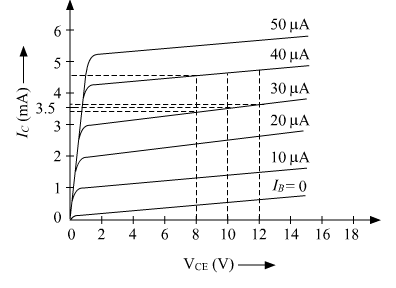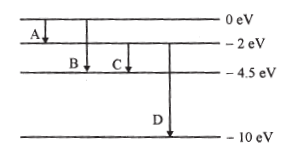CBSE
Class 10 Class 12
Download this Physics Pre Board Paper 3 for taking the test offline or sharing with your friends. Once you are done with all the answers to the questions, Go ahead with answer key to check your answers.

General Instructions:
There is no overall choice. However, an Internal Choice has been provided in one question of Two Marks, one question of Three Marks and all the Three Questions of Five Marksweightage. You have to attempt only one of the choices in such Questions.

| 1. | What is meant by capacitance? Give its SI unit. | [1] |
| 2. |
Graph showing the variation of current versus voltage for a material GaAs is shown in the figure. Identify the region of i) negative resistance ii) where Ohm’s law is obeyed.
| [1] |
| 3. |
A plane electromagnetic wave travels in vacuum along z-direction. What can you say about the direction of electric and magnetic field vectors? | [1] |
| 4. | How are side bands produced? | [1] |
| 5. | What is the value of refractive index of a medium of polarizing angle 60°? | [1] |

| 6. | If the temperature of a good conductor decreases, how does the relaxation time of electrons in the conductor change? | [2] |
| 7. |
The given graph shows the variation of photo-electric current (I) versus applied voltage (V) for two different photosensitive materials and for two different intensities of the incident radiation. Identify the pairs of curves that correspond to different materials but same intensity of incident radiation. | [2] |
How does one explain, using de Broglie hypothesis, Bohr's second postulate of quantization of orbital angular momentum?
| 8. |
Write the functions of the following in communication systems: (i) Transducer (ii) Repeater | [2] |
| 9. | Out of the two characteristics—the mass number (A) and the atomic number (Z) of a nucleus, which one does not change during nuclear α-decay? | [2] |
| 10. | How does the angle of minimum deviation of a glass prism vary, if the incident violet light is replaced with red light? | [2] |

| 11. |
Two capacitors of unknown capacitances C1 and C2 are connected first in series and then in parallel across a battery of 100 V. If the energy stored in the two combinations is 0.045 J and 0.25 J respectively, determine the value of C1 and C2. Also, calculate the charge on each capacitor in parallel combination. | [3] |
| 12. |
State the underlying principle of a potentiometer. Write two factors by which current sensitivity of a potentiometer can be increased. Why is a potentiometer preferred over a voltmeter for measuring the emf of a cell? | [3] |
| 13. |
Two identical circular wires P and Q each of radius R and carrying current ‘I’ are kept in perpendicular planes such that they have a common center as shown in the figure. Find the magnitude and direction of the net magnetic field at the common center of the two coils.
| [3] |
| 14. | The magnetic field of an electromagnetic wave oscillates parallel to a y-axis and is given by By = B0y sin (kz - ωt). (a) In what direction does the wave travel and (b) parallel to which axis does the associated electric field oscillate? | [3] |
| 15. |
a) Write the expression for the magnetic force acting on a charged particle moving with velocity v in the presence of magnetic field B. | [3] |
| 16. |
Output characteristics of an n-p-n transistor in CE configuration is shown in the figure. Determine: (a) Dynamic output resistance (b) DC current gain and (c) AC current gain at an operating point VCE=10V, when IB=30 A. A. 
| [3] |
| 17. | Write three characteristic features in photoelectric effect that cannot be explained on the basis of wave theory of light, but can be explained only using Einstein's equation. | [3] |
| 18. |
(i) State law of Malus. | [3] |
| 19. |
The energy levels of a hypothetical atom are shown below. Which of the shown transitions will result in the emission of a photon of wavelength 275 nm? Which of these transitions correspond to emission of radiation of (i) maximum and (ii) minimum wavelength?
| [3] |
| 20. | Write the two processes that take place in the formation of a p-n junction. Explain with the help of a diagram, the formation of the depletion region and barrier potential in a p-n junction. | [3] |
| 21. |
Write any two factor which justify the need for modulating a signal. Draw a diagram showing an amplitude modulated wave by superposing a modulating signal over a sinusoidal carrier wave. | [3] |
| 22. | Ultraviolet radiations of different frequencies v1 and v2 are incident on two photosensitive materials having work functions W1 and W2 (W1 > W2) respectively. The kinetic energy of the emitted electrons is same in both the cases. Which one of the two radiations will be of higher frequency? | [3] |

| 23. |
One day Chetan’s mother developed a severe stomach ache all of a sudden. She was rushed to the doctor who suggested for an immediate endoscopy test and gave an estimate of expenditure for the same. Chetan immediately contacted his class teacher and shared the information with her. The class teacher arranged for the money and rushed to the hospital. On realizing that Chetan belonged to a below average income group family, even the doctor offered concession for the test fee. The test was conducted successfully. Answer the following questions based on the above information: (a) Which principle in optics is made use of in endoscopy? (b) Briefly explain the values reflected in the action taken by the teacher. (c) In what way do you appreciate the response of the doctor on the given situation? | [4] |

| 24. |
(a) Explain, using suitable diagrams, the difference in the behaviour of a (i) conductor and (b) A thin metallic spherical shell of radius R carries a charge Q on its surface. A point charge Q/2 is placed at its centre C and another charge +2Q is placed outside the shell at a distance x from the centre as shown in the figure. Find (i) the force on the charge at the centre of shell and at the point A, | [5] |
| 25. |
Derive an expression for the impedance of a series LCR circuit connected to an AC supply of variable frequency. Plot a graph showing variation of current with the frequency of the applied voltage. Explain briefly how the phenomenon of resonance in the circuit can be used in the Tuning mechanism of a radio or a TV set. | [5] |
An LC circuit contains a 20 mH inductor and a 50 μF capacitor with an initial charge of 10 mC. The resistance of the circuit is negligible. Let the instant the circuit is closed be t = 0.
(a) What is the total energy stored initially? Is it conserved during LC oscillations?
(b) What is the natural frequency of the circuit?
(c) At what time is the energy stored
(i) completely electrical (i.e., stored in the capacitor)?
(ii) completely magnetic (i.e., stored in the inductor)?
(d) At what times is the total energy shared equally between the inductor and the capacitor?
(e) If a resistor is inserted in the circuit, how much energy is eventually dissipated as heat?
| 26. |
(a) Obtain lens makers formula using the expression Here the ray of light propagating from a rarer medium of refractive index (n1) to a denser medium of refractive index (n2) is incident on the convex side of spherical refracting surface of radius of curvature R. (b) Draw a ray diagram to show the image formation by a concave mirror when the object is kept between its focus and the pole. Using this diagram, derive the magnification formula for the image formed. | [5] |
Describe Young's double slit experiment to produce interference pattern due to a monochromatic source of light. Deduce the expression for the fringe width.